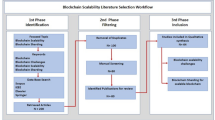Abstract
In recent years, with the rapid development of blockchain, blockchain technology has been widely used in various scenarios. The application of blockchain in the carbon trading market is of great significance to help achieve carbon peak and carbon neutrality goals. However, the performance of the traditional blockchain cannot meet the needs of large-scale and high-concurrent transactions in the carbon market. At the same time, the blockchain is also facing huge storage pressure in the face of large-scale carbon data. To solve the problem of on-chain storage pressure, we propose a carbon trading system architecture based on on-chain and off-chain collaborative storage, which standardizes the execution steps of carbon trading and the process of data storage and acquisition. To improve the performance of blockchain, we propose a double layer consensus optimization mechanism in DAG(Directed Acyclic Graph)-based blockchain. The local sharding and global sharding form a two-layer consensus architecture, and the Sim-Hashgraph consensus algorithm is proposed to improve the consensus efficiency. Finally, experimental simulations verify that the Sim-Hashgraph consensus algorithm can effectively improve the consensus efficiency, and verify the effectiveness of the Sim-Hashgraph based sharding blockchain architecture.
Supported by the National Key R&D Program of China(2022YFB2703400), Supported by BUPT Excellent Ph.D. Students Foundation(CX20241008).
Access this chapter
Tax calculation will be finalised at checkout
Purchases are for personal use only
Similar content being viewed by others
References
Ge, J.: Blockchain-based carbon emissions trading system. Master’s thesis, Shandong University (2022)
Guo, H., Yu, X.: A survey on blockchain technology and its security. Blockchain: Res. Appl. 3(2), 100067 (2022)
Pan, Y., et al.: Application of blockchain in carbon trading. Energy Procedia 158, 4286–4291 (2019)
Yan, S., Zhang, Y., Kai, W.: Blockchain technology helps the path research of digital carbon neutrality. Information and Communication Technology and Policy, pp. 81–83 (2022)
Li, W., He, M.: Comparative analysis of bitcoin, ethereum, and libra. In: 2020 IEEE 11th International Conference on Software Engineering and Service Science (ICSESS), pp. 545–550. IEEE (2020)
Song, Yu., et al.: A blockchain-based method for optimizing the routing of high-frequency carbon-trading payment channels. Electronics 12(12), 2586 (2023)
Liu, Y., et al.: A flexible sharding blockchain protocol based on cross-shard byzantine fault tolerance. IEEE Trans. Inf. Forensics Secur. 18, 2276–2291(2023)
Wang, Q., Jiangshan, Yu., Chen, S., Xiang, Y.: Sok: DAG-based blockchain systems. ACM Comput. Surv. 55(12), 1–38 (2023)
Khaqqi, K.N., Sikorski, J.J., Hadinoto, K., Kraft, M.: Incorporating seller/buyer reputation-based system in blockchain-enabled emission trading application. Appl. Energy 209, 8–19 (2018)
Liang, X., Du, Y., Wang, X., Zeng, Y.: Design of a double-blockchain structured carbon emission trading scheme with reputation. In: 2019 34rd Youth Academic Annual Conference of Chinese Association of Automation (YAC), pp. 464–467. IEEE (2019)
Ningjie Gao, R., Huo, S.W., Huang, T., Liu, Y.: Sharding-hashgraph: a high-performance blockchain-based framework for industrial internet of things with hashgraph mechanism. IEEE Internet Things J. 9(18), 17070–17079 (2021)
Wang, J., Wang, S., Zhang, Q., Deng, Y.: A two-layer consortium blockchain with transaction privacy protection based on sharding technology. J. Inf. Secur. Appl. 74, 103452 (2023)
Feng, L., Yang, Z., Guo, S., Qiu, X., Li, W., Peng, Yu.: Two-layered blockchain architecture for federated learning over the mobile edge network. IEEE Network 36(1), 45–51 (2021)
Yuan, S., Cao, B., Peng, M., Sun, Y.: Chainsfl: blockchain-driven federated learning from design to realization. In: 2021 IEEE Wireless Communications and Networking Conference (WCNC), pp. 1–6. IEEE (2021)
Zhang, Q., Wang, S., Zhang, D., Wang, J., Sun, J.: FortunChain: EC-VRF-based scalable blockchain system for realizing state sharding. IEEE Trans. Network Serv. Manage. 20(4), 4340–4353 (2023)
James, J., Hawthorne, D., Duncan, K., St. Leger, A., Sagisi, J., Collins, M.: An experimental framework for investigating hashgraph algorithm transaction speed. In: Proceedings of the 2nd Workshop on Blockchain-enabled Networked Sensor, pp. 15–21 (2019)
Author information
Authors and Affiliations
Corresponding author
Editor information
Editors and Affiliations
Rights and permissions
Copyright information
© 2025 The Author(s), under exclusive license to Springer Nature Switzerland AG
About this paper
Cite this paper
Song, Y. et al. (2025). A Double Layer Consensus Optimization Mechanism in DAG-Based Blockchain for Carbon Trading. In: Cai, Z., Takabi, D., Guo, S., Zou, Y. (eds) Wireless Artificial Intelligent Computing Systems and Applications. WASA 2024. Lecture Notes in Computer Science, vol 14997. Springer, Cham. https://doi.org/10.1007/978-3-031-71464-1_12
Download citation
DOI: https://doi.org/10.1007/978-3-031-71464-1_12
Published:
Publisher Name: Springer, Cham
Print ISBN: 978-3-031-71463-4
Online ISBN: 978-3-031-71464-1
eBook Packages: Computer ScienceComputer Science (R0)




